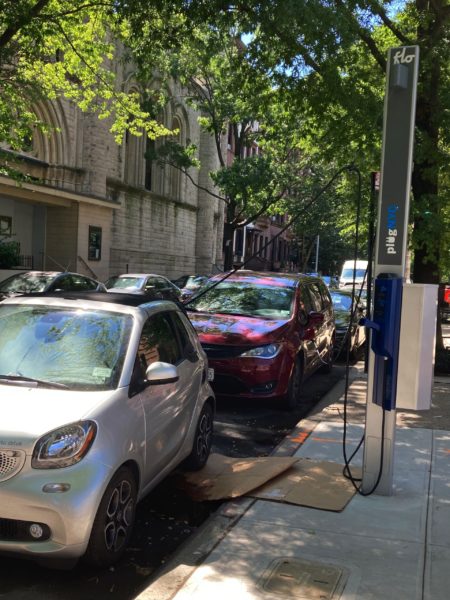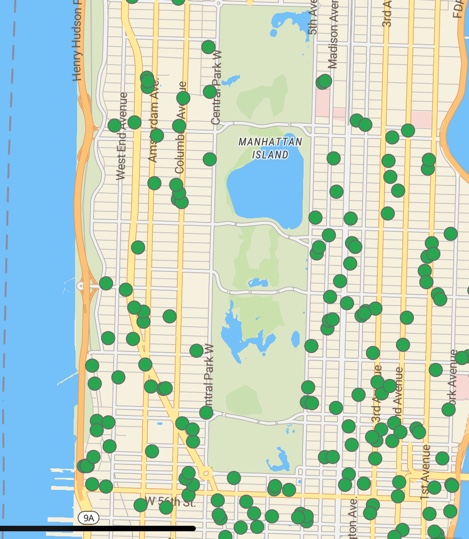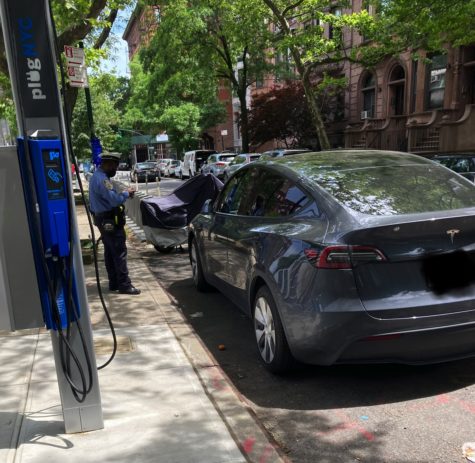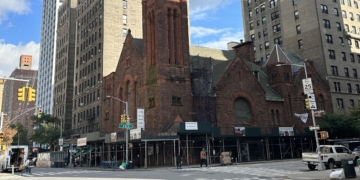
By Daniel Katzive
Gas is expensive. The planet is getting hot. The internal combustion engine, which has been powering cars for over 100 years, is on the way out. Electric-powered vehicles are the future.
All of these are common refrains, perhaps particularly common from our out-of-town friends or relatives who are already driving electric vehicles (EVs). But what if you’re a climate-conscious Upper West Sider?
Well, if you live here, odds are you don’t own any kind of car. According to U.S. Census data, as of 2020 there were about 106,000 households living in the zip codes comprising the Upper West Side, while New York State data shows only 32,000 passenger vehicles registered in those zip codes, suggesting that less than a third of Upper West Side households own a car. Compare that with the overall numbers for New York State, where the average household owns 1.25 passenger vehicles. In a neighborhood like ours with ample public transportation, the most economical and climate-conscious practice is to eschew a vehicle altogether.
To the extent Upper West Siders do have their own vehicles, it is a bit more likely to be an EV than it is for New York State residents as a whole. There are currently 578 EVs registered in UWS zip codes, according to Department of Motor Vehicle records; 520 of those are Teslas. This may not seem like a large number in densely populated neighborhood liked ours. But statewide, just 0.5 percent of all registered vehicles are EVs; on the Upper West Side that figure is 1.7 percent.
So who are those 578 EV owners, and how do they manage this new technology in the city, which is not exactly EV-friendly at this point? Perhaps because there are so few of them, The Rag struggled to make contact with EV owners in the neighborhood, but did talk with a number of sources who described the challenges of maintaining an EV in a urban space like New York City.
Marc Geller, a spokesperson for the 50-year-old nonprofit Electric Vehicle Association of America, said the economics of EV ownership are straightforward for those who can charge a car at home. EV fuel costs can be just 25-30 percent of the costs for an equivalent gasoline-powered car, and maintenance costs are lower thanks to the absence of an engine. “However, once you use a third-party system [for charging], that system has to make money,” said Geller. “And there is no regulation for the public selling of electricity to charge cars, even for a public utility.”
Of course, owning any car in New York City is more complicated than it is in most of the rest of the country. Parking spots on the street can be hard to come by and cars must be moved twice a week for street cleaning. Snow storms and theft can also be problems.
Filling up with gas is also not always so straightforward. Gas prices are higher (around $5.11 per gallon in New York City currently, according to the U.S. Energy Information Agency). And the Upper West Side is down to just one gas station, on 96th Street between West End Avenue and the Henry Hudson Parkway. (Long-time residents may remember that the Jewish Community Center at Amsterdam Avenue 76th Street now sits on the site of what was a gas station until the early 1990s, and the station at Frederick Douglass Circle on 110th Street was replaced by a luxury condominium a few years ago.)
But there is additional complexity for an UWS EV owner: most of us live in apartment buildings, and very few have dedicated parking spots – let alone parking spots with access to electricity. Increasingly, neighborhood parking garages do offer charging services for EVs, but, as with most things in New York City, convenience comes with a cost.
For starters, the cost to park your car in an UWS garage can exceed the cost to rent a small apartment in other large cities (or a large apartment in some small cities!). On top of the monthly rate, city residents pay 10.375 percent parking tax. According to Spothero.com, the average monthly parking cost in New York City is $570, and the web site did not list any garages charging less than $700 on the Upper West Side, though we note that vehicle owners can sometimes negotiate lower rates with individual garages.
The additional fee for keeping your EV charged can be large; our informal survey turned up parking garage rates for charging EVs that ranged from $50 to several hundred dollars per month for unlimited charging.
However, with a full tank of gasoline costing nearly $100 now for a car with an 18-gallon tank, drivers who use their car frequently might find the economics attractive. And keeping your EV in a pricey parking garage has the added convenience of not having to look for gas (imagine if your garage topped up your gas tank for you!). If you use your car less often, some garages also offer one-time or hourly charging rates as low as $10 (in addition to parking), which might be a better deal than paying a flat monthly fee.

For street parkers, though, EV ownership is considerably more complicated. There are public curbside charging stations, but they are few and far between; the city-wide network of public chargers, PlugNYC, consisted of 96 curbside chargers as of June 22, according to the NYC Department of Transportation.
There are three public charging stations (each with two connectors) on the UWS: West 76th Street between Amsterdam and Columbus; West 84th Street between Amsterdam and Columbus; and West 93rd Street between Central Park West and Columbus Avenue.
To access these stations, drivers use an app called FLO to locate nearby stations, reserve a time for a charging session, and pay for it. The pricing is $1.00 per hour from 7pm and 7am, and $2.50 per hour from 7am to 7pm.
These chargers, installed in partnership with Con Edison, can “provide an EV with up to 20 miles of range per hour,” a sign on the charger says. The rules on the charger say that “only EVs that are plugged into the charger are authorized to park here.”
The city plans to install 1,000 curbside stations by 2025 and 10,000 by 2030, according to a September 2021 DOT press release. But right now, it would be difficult to count on finding an open charger regularly. Periodic visits to the chargers on West 76th Street this past month found the spots sometimes vacant, but also sometimes blocked by non-EVs parked illegally (in some cases ticketed).

When there was an EV in the space, it was not always plugged in or, according to the screen on the charger, not actually charging even if it was plugged in. On one occasion, we did observe a parking agent ticketing a Tesla which was in a charging spot but not plugged in. On another occasion, an unplugged-in Tesla was not ticketed and perhaps protected by its placard from the NYPD Sergeants’ Benevolent Association.
EVs we saw charging in the spots had usually been there for many hours, according to the information displayed on the Flo screen, in one case for over 13 hours, suggesting that open times for charging might be hard to find – especially since UWS residents with EVs must also compete with commuters for charger access. EVs we saw charging on 76th Street often had out of state plates and, in cases where New York State plates were displayed, a check of the DMV’s database showed the cars were not registered to owners with UWS zip codes.
A flexible approach to charging might work, however, if a street parker was willing to occasionally park in a garage and pay a one-time charger fee. If the car is used to commute out of Manhattan to a location with chargers this could also reduce an EV owner’s dependency on street charging. One EV owner who spoke to the West Side Rag told us he uses his EV to commute to a job in the West Village and will typically charge his car once a month using an hourly rate offered at various garages.
Plug-in hybrids are another option for Upper West Side residents who want to reduce their carbon footprint but not risk being marooned without any juice. Plug-in hybrids have a standard internal combustion engine as well as a battery and electric motor that can be charged with external power. While these vehicles do provide more flexibility, they do not reap the maintenance savings that are a key part of the value proposition for an EV, because there is still an internal combustion engine that must be maintained. Marc Geller of the EV Owners Association also points out that some of these plug-in hybrids on the market do not have large battery capacity, meaning the vehicle will often be running on gasoline.
EVs are actually for sale on the Upper West Side. Polestar, a Swedish electric vehicle manufacturer spun off by Volvo in 2017, has a dealership at the corner of West 66th Street and Amsterdam Avenue. A salesperson we spoke to there told us that some New York City buyers of EVs do take advantage of charging facilities on the other side of the river in New Jersey, where they presumably work or have other reasons to visit regularly. The DMV data we reviewed did not show ANY Polestar electric vehicles registered on the Upper West Side, though they could have been included among the 8 “other” makes registered or perhaps among the three Volvos. Most likely the dealership is mainly selling cars to customers who live outside the city and are here for work.
Do you own an EV and live on the Upper West Side? We would love to hear about your experience. Please feel free to use the comment fields below or email us at info@westsiderag.com with the subject line “EV Article”. If we get enough responses, we will consolidate your comments (anonymously if you prefer) in a future article.
Additional reporting by Scott Etkin.









My neighbor had an electrician install a charging station and meter at his parking spot in the basement garage.
Someone used to park their Chevy Volt on W95th St and run the charging cable out of their brownstone, across the sidewalk and sometimes even across the street. There was a letter about it in the Times a few years ago.
Household chargers take more than 8 hours to recharge a small battery powered car like the Chevy Bolt.
One needs industrial service to charge a car in an hour or two.
He didn’t mention a thing about charging times. Not sure your point?
My point is that recharging in your own garage or in front of your house on the street is still a very slow process, even if you’ve paid an electrician to install a home charger.
Next to universally, the service to homes/houses (and small apartment buildings) will not support the use of a “fast” charger, which would cost tens of thousand of dollars to purchase anyhow.
So I am highlighting the severe limitations of home charging.
Compounding the problems for home charging: In colder cities, say Buffalo, or the even colder Minneapolis, home charging in the winter must be done within a heated garage — say kept at 40 degrees Fahrenheit. This is because cold below 15 degrees F severely degrades the range of battery operated cars, Teslas, Bolts, Leafs.
The if the destination is more than 100 miles away and you expect to make the return trip on the same day, you’ll need a “fast” charger operating in a heated garage.
Example: So no, you can’t visit you aunt in Albany for lunch and expect to drive back on a cold winter day, unless your aunt has a heated garage where you park while at lunch, and then you have ready access to a “fast” charger (which will not be in your aunt’s garage) again in a heated garage where you can “fill up” before making the return trip to NYC in the evening.
You can definitely charge and drive EVs in cold weather, we do it at work all the time.
The range is severely reduced below 15 degrees Fahrenheit.
I didn’t simply say “cold weather”.
I can tell you didn’t thoroughly read my comme nt.
EV’s are not necessarily “the future.” There are still horrible emissions and waste that come from the production of electric vehicles, not just the burning of fuel. Furthermore, many of the chemicals used in industrial batteries are extraordinarily toxic and bad for both humans and nature.
And current and foreseeable battery technology isn’t useful for long distances in temperatures below 15 degrees Fahrenheit.
It seems to me that rational people can make decisions that work for them. Perhaps EV owners have second homes or reverse commute to a suburb, and can charge in those locations?
And quick charge-ups are available on route, if one needs an extra 50 miles of power.
We need to plant some more electricity trees! Oh, wait electricity comes from fossil fuels. Electric cars, windmills etc. None of it is an improvement. If we want to get serious then let’s start building next-gen nuclear plants.
Or maybe support more and better public transportation?
You’ve got to be kidding. Just what do you do with the spent fuel? There are many safer and better alternatives Or haven’t you heard of Solar, Wind, etc.
If you don’t build nuclear plants and depend on wind a solar (need very large batteries) NYC will only have power 10-12 hours a day. And the batteries in the EV’s are equally toxic to spent fuel rods
LOL. That was funny. Thanks.
Well-reported and fascinating story full of useful info. Thanks. It sounds as if EV-ownership is still more aspirational than reality for most UWS residents.
When Full Self Driving is deployed later this year it will be a lot easier. Cars will drive to a charging station in a rural area where there are no wait times and prices are lower because they have access to clean renewable Wind Power and then come back fully charged.
Just a little correction. Polestar is indeed a sub brand of Volvo but Volvo is owned by Chinese company Geely and all Polestars are made in China not in Sweden as your article suggests.
Thank you. Polestar was spun off by Volvo and is incorporated in Sweden, so it is a “Swedish auto manufacturer” but, as you correctly point out, the location of where cars are actually manufactured often does not correspond to the parent company’s home address, and in Polestar’s case manufacturing does take place in China.
Great article — appreciate the research!
I have a 2017 plug-in Prius hybrid. It doesn’t make economic sense to charge it anywhere in the borough. Trust me, I’ve tried for 5 years.
As a born-and-raised UWSer who is lucky enough to still have a place there while living most of the time in Park City, Utah, I can tell you the EV is the future. Out west the infrastructure has been in place for a while and it has worked brilliantly for most of us. I’m on my third Tesla, I charge at home with ease, there are charging stations everywhere, Supercharger stations abound, and solar, wind, and hydroelectric power generation is huge. Unfortunately, just not in New York City.
In 2020 almost 60% of California’s energy came from renewable or zero carbon sources. And now, on some days, California’s grid is able to reach into the high 90s percentage-wise. It’s possible to go zero carbon if governments and providers make the commitment. New York State is making a good start at 28% renewable energy, but the people and the government need to keep pushing for more. We’re at the beginning of something and just because the results aren’t where we want them to be at the very end of this process, let’s be glad for the incredible progress that’s being made, rather than shit on EVs and Green Energy efforts. They’re solving huge problems with absolutely no help from the GOP or the powerful fossil fuel lobby.
New York City is obviously a different place with different charging challenges than suburbs and rural areas. But if the demand is there for chargers, someone will find a way to provide it. After all, Manhattan was the first place on Earth with an electrified neighborhood when Edison put in a generator at 257 Pearl Street in 1882. People thought the idea of wiring that first ¼ mile of the city for electricity, much less each-and-every building, office, apartment, and room, in the entire city, was crazy. So, how crazy is a few thousand car chargers?
EVs have many fewer parts, need much less maintenance, are fast, are quiet, are cheaper to maintain, don’t need oil or fluids, and no one goes to war over electricity or bows to despots over wind power. As long as we continue to find green energy sources, responsibly secure the metals we need for the batteries, and recycle the cars at the end of their lives into new ones, we’re still environmentally ahead of internal combustion vehicles.
A key difference – you need a car to get around in Utah.
You *don’t* need a car to get around NYC. The future is fewer cars, not cars of a different type. Cities are made for people, not vehicles – and yes, whatever cars are left should be EVs/non-fossil fuel, but the sheer obsession with driving on WSR is a very clear sign of the suburbanization of the UWS over the past few decades
While you don’t need a car to get around the city in most cases, you often need one to leave it and return. For people who work in New Jersey or spend weekends upstate or care for an elderly family member in Westchester or have clients on Long Island, the 104 bus doesn’t do them much good. Additionally, if you’re hauling tile samples or carpet cleaning equipment from Sheepshead Bay to Staten Island, but live in Lincoln Square, perhaps trains and stairs aren’t your best bet. Everyone has different needs and desires, and one size does not fit all.
Sometimes even Manhattanites need cars, and if they do, it would be nice if they had the option of ones that were quiet and had no tailpipe emissions for the rest of us to breathe.
Lincoln Towers is about to install hundreds of chargers in their parking lots. When that happens I will install a charger in our upstate house and join the ranks of EV owners.
This is hilarious. It’s NYC. It’s Manhattan. You’re in the midst of one of the best-served neighborhoods for public transit in North America. You DON’T NEED TO OWN A CAR.
You’re right, if you don’t plan to go outside of Manhattan. And while some Manhattanites think it’s the center of the Earth, some want to get out periodically.
‘There are more things in heaven and earth, Horatio, / Than are dreamt of in your philosophy.’
Try putting yourself into the shoes of people whose life experiences, needs, and tastes don’t match yours.
EV’s make tons of sense for areas that are not blanketed by public transportation. The shorter the commute, 15 miles one way or less, the more the scale tips in favor of EV’s. Short trips like that are considered severe service miles for an ICE vehicle. DCFC’s are featured in NYS Thruway service areas. For that matter, the northeast corridor has many many places to charge.
I own a Tesla Model Y. I park it in a garage on W 59th in my ex-wife’s building. They have several tesla chargers and J1772 chargers. I used to own a Model S and parked on the street and charged at JFK or in Tarrytown. I got sick of that after 6 months and sold it.
Why is the city allowing curbside charging at all? This institutionalizes cars’ right to the curb and precludes other uses like bike lanes for all time. Better to make parking garages charge nothing or a small amount for EVs that charge there.